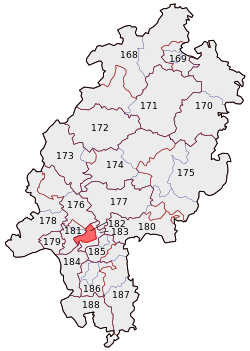Frankfurt am Main I (electoral district)
Frankfurt am Main I is one of the 299 single member constituencies used for the German parliament, the Bundestag. One of twenty two districts covering the state of Hesse and one of two in the city of Frankfurt, it covers the northern and western parts of the city.

Location of constituency in Hesse
The constituency was created for the 1949 election, the first election in West Germany after World War II. Throughout its history the constituency has been won by the two main German parties the Social Democratic Party of Germany (SPD) and the Christian Democratic Union (CDU). The current representative is Matthias Zimmer of the CDU, who was first elected at the 2009 general election.
Boundaries
| Election(s) | District name and number | Areas covered |
|---|---|---|
| 1949 | 15 Frankfurt/M I | The Frankfurt city districts of Oberrad, Sachsenhausen, Niederrad, Goldstein, Schwanheim, Griesheim, Nied, Höchst, Sindlingen, Zeilsheim, Unterliederbach and Sossenheim |
| 1953–1961 | 140 Frankfurt/M I | |
| 1965–1972 | 140 Frankfurt I | |
| 1976 | 140 Frankfurt (Main) I – Main-Taunus | The Frankfurt city districts of Höchst, Schwanheim, Griesheim, Nied, Sindlingen, Zeilsheim, Unterliederbach, Sossenheim, Rödelheim, Hausen, Praunheim and Goldstein-West; From Main-Taunus-Kreis, the towns and municipalities of Bad Soden, Eschborn, Hattersheim am Main, Kriftel, Liederbach am Taunus, Schwalbach am Taunus and Sulzbach |
| 1980–1998 | 138 Frankfurt am Main I – Main-Taunus | |
| 2002-2005 | 183 Frankfurt am Main I | The Frankfurt city districts of Altstadt, Bahnhofsviertel, Bockenheim, Dornbusch, Eschersheim, Gallusviertel, Ginnheim, Griesheim, Gutleutviertel, Hausen, Heddernheim, Höchst, Innenstadt, Nied, Niederursel, Praunheim, Rödelheim, Sindlingen, Sossenheim, Unterliederbach, Westend and Zeilsheim[1] |
| 2009-2013 | 182 Frankfurt am Main I |
Results
2013 election
| Party | Constituency results | List results | ||||||
|---|---|---|---|---|---|---|---|---|
| Candidate | Votes | % share | +/- | Votes | % share | +/- | ||
| Christian Democratic Union | Matthias Zimmer | 52,427 | 40.2 | +4.9 | 43,883 | 33.5 | +0.5 | |
| Social Democratic Party of Germany | Gregor Amann | 43,124 | 33.0 | +3.0 | 35,106 | 26.8 | +4.5 | |
| Alliance '90/The Greens | Angela Anne Hanisch | 12,875 | 9.9 | -2.2 | 17,398 | 13.3 | -2.5 | |
| The Left | Eva Margarete Wieme | 10,280 | 7.9 | -1.4 | 11,684 | 8.9 | -2.2 | |
| Free Democratic Party | Hans-Joachim Otto | 4,125 | 3.2 | -6.7 | 9,209 | 7.0 | -10.4 | |
| Pirate Party | Thorsten Wirth | 3,066 | 2.3 | N/A | 3,117 | 2.4 | -0.2 | |
| Free Voters | Rainer Drephal | 1,586 | 1.2 | N/A | 904 | 0.7 | N/A | |
| National Democratic Party of Germany | Martin Patrick Baumgart | 1,148 | 0.9 | -0.1 | 949 | 0.7 | -0.2 | |
| The Republicans | Frank-Michael Homa | 772 | 0.6 | -0.1 | 450 | 0.3 | -0.3 | |
| Die PARTEI | Nico Wehnemann | 939 | 0.7 | N/A | 869 | 0.7 | N/A | |
| Bürgerrechtsbewegung Solidarität | Ilja Bertold Karpowski | 177 | 0.1 | -0.1 | 85 | 0.1 | -0.1 | |
| Alternative for Germany | N/A | N/A | N/A | N/A | 6,983 | 5.3 | N/A | |
| Others | 251 | 0.1 | N/A | |||||
Source:[2]
List of district representatives
| Election | Name | Party |
|---|---|---|
| 1949 | Hermann Brill | SPD |
| 1953 | Peter Horn | CDU |
| 1957 | Peter Horn | CDU |
| 1961 | Georg Leber | SPD |
| 1965 | Georg Leber | SPD |
| 1969 | Georg Leber | SPD |
| 1972 | Georg Leber | SPD |
| 1976 | Karsten Voigt | SPD |
| 1980 | Karsten Voigt | SPD |
| 1983 | Heinz Riesenhuber | CDU |
| 1987 | Heinz Riesenhuber | CDU |
| 1990 | Heinz Riesenhuber | CDU |
| 1994 | Heinz Riesenhuber | CDU |
| 1998 | Heinz Riesenhuber | CDU |
| 2002 | Gudrun Schaich-Walch | SPD |
| 2005 | Gregor Amann | SPD |
| 2009 | Matthias Zimmer | CDU |
| 2013 | Matthias Zimmer | CDU |
gollark: Like someone said in the comments, they can just run it all the way to the heat death of the universe instantly and fix that.
gollark: I don't see why you would want that. One infinitely powerful hypercomputer can do the same as whatever amount of infinitely powerful hypercomputers in zero time.
gollark: You get... two simulations, one different, presumably?
gollark: I didn't say it was proof, just that it wasn't disproof.
gollark: <@221827050892296192> Those are just maths. There are no *actual* circles to infinite precision in the real world. We just know that the abstract idea of circles and whatnot follows those rules, and matches real-world ones fairly well in most situations.
References
- Constituency boundaries Archived 2014-03-03 at the Wayback Machine, bundeswahlleiter.de, accessed 3 March 2014
- 2013 constituency results Archived 2014-03-03 at the Wayback Machine, bundeswahlleiter.de, accessed 3 March 2014
This article is issued from Wikipedia. The text is licensed under Creative Commons - Attribution - Sharealike. Additional terms may apply for the media files.